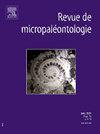Tekkeina anatoliensis Farinacci & Yeniay, 1995 hemipelagic larger benthic foraminifer from the Santonian Ilam Formation of west-southwestern Iran: emendation of the genus and suprageneric status
IF 1
Q4 PALEONTOLOGY
引用次数: 0
Abstract
The agglutinated foraminifer Tekkeina anatoliensis Farinacci & Yeniay (Santonian of Turkey) is here reported for the first time from the Ilam Formation of west-southwestern Iran. The genus Tekkeina is emended to include a facultative uncoiling and branching adult test part. Test sizes of > 5.0 mm for the uncoiling specimens, although displaying a simple internal structure, means that T. anatoliensis, can be considered a larger benthic foraminifer. The previous suprageneric classification within the Schlumbergerinidae Mikhalevich & Kaminski of the subclass Tubothalamana is rejected. Displaying striking similarities to Navarella Ciry & Rat (Maastrichtian of Spain), and Neonavarella Giusberti et al. (Thanetian of Italy), Tekkeina is placed into the same family, the Ammobaculinidae Saidova of the subclass Globothalamana, re-instating the original taxonomic assignment. The three genera display a convergent evolution within similar palaeoenvironments and facies as autochthonous elements in limestones with planktonic foraminifera and calcisphaerulids in hemipelagic to bathyal environments. The Santonian age of the Iranian specimens confirms its biostratigraphic utility. It is the first record from the Middle East area, namely the Arabian Plate.
Tekkeina anatoliensis Farinacci & Yeniay, 1995伊朗西南西部Santonian Ilam组半深海大型底栖有孔虫:属和超属地位的修正
本文首次报道了在伊朗西南西部Ilam组发现的凝集有孔虫Tekkeina anatoliensis Farinacci & &; Yeniay(土耳其圣东统)。该属被修订,以包括一个兼性展开和分支成人测试部分。展开标本的测试尺寸为5.0 mm,虽然显示出简单的内部结构,但这意味着T. anatoliensis可以被认为是一种更大的底栖有孔虫。先前在Schlumbergerinidae中Mikhalevich & Kaminski对Tubothalamana亚纲的超属分类被拒绝。Tekkeina与Navarella city & &; Rat(西班牙的Maastrichtian)和Neonavarella Giusberti et al.(意大利的Thanetian)有着惊人的相似之处,被归入同一科,即Globothalamana亚纲的ammobaculindae Saidova,重新恢复了最初的分类分配。这三个属在相似的古环境和相中表现出趋同的演化,在半深海到深海环境中与浮游有孔虫和钙质生物同为原生元素。伊朗标本的圣安东尼奥时代证实了它在生物地层学上的实用性。这是来自中东地区,即阿拉伯板块的第一个记录。
本文章由计算机程序翻译,如有差异,请以英文原文为准。
求助全文
约1分钟内获得全文
求助全文
来源期刊

REVUE DE MICROPALEONTOLOGIE
PALEONTOLOGY-
CiteScore
2.50
自引率
0.00%
发文量
17
期刊介绍:
La Revue de micropaléontologie publie 4 fois par an des articles de intérêt international, consacrés à tous les aspects de la micropaléontologie. Les textes, en anglais ou en français, sont des articles originaux, des résultats de recherche, des synthèses et mises au point, des comptes rendus de réunions scientifiques et des analyses de ouvrages. La revue se veut résolument ouverte à tous les aspects de la micropaléontologie en accueillant des travaux traitant de la systématique des microfossiles (et de leurs équivalents actuels), des bactéries aux microrestes de vertébrés, et de toutes leurs applications en sciences biologiques et géologiques.
 求助内容:
求助内容: 应助结果提醒方式:
应助结果提醒方式:


